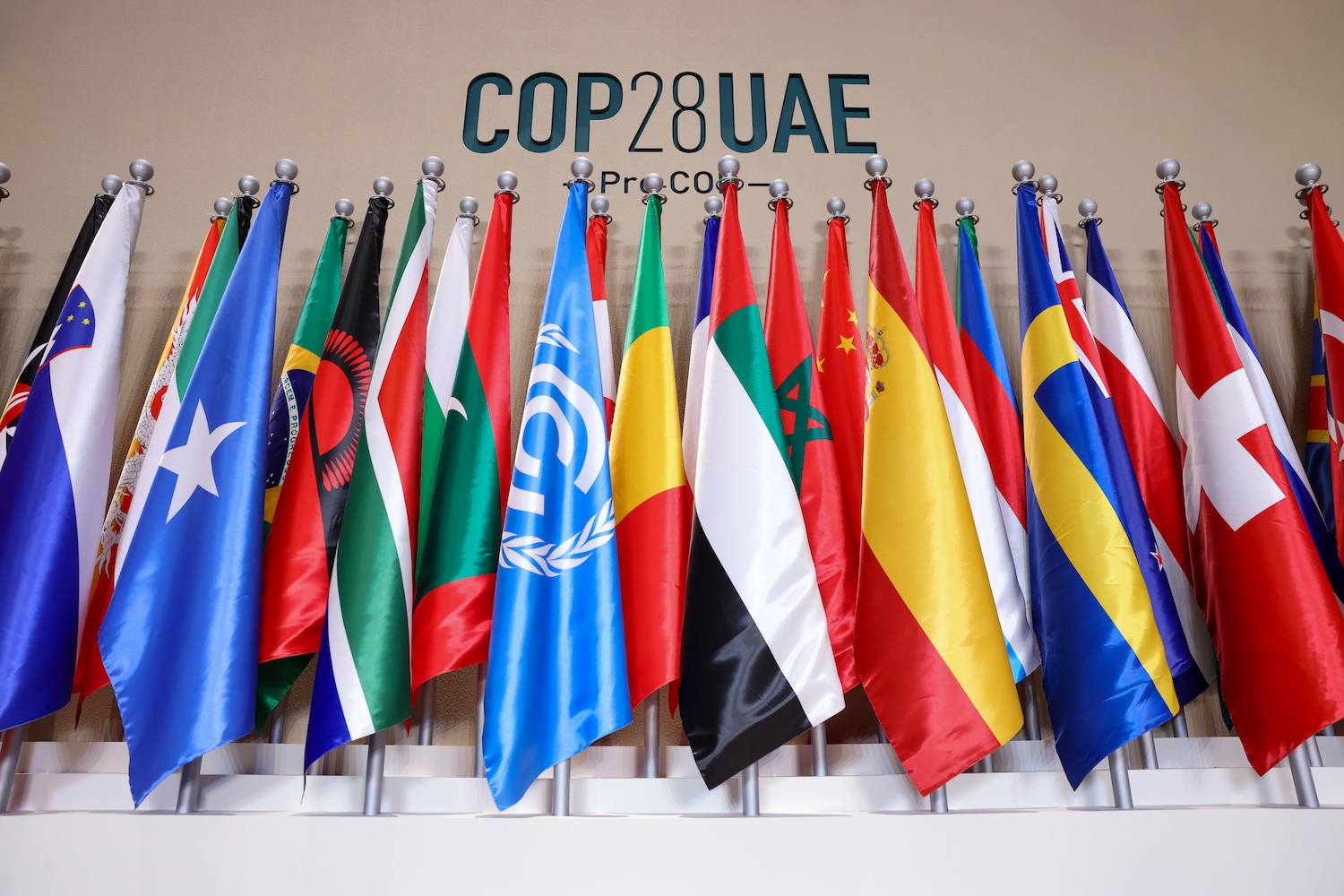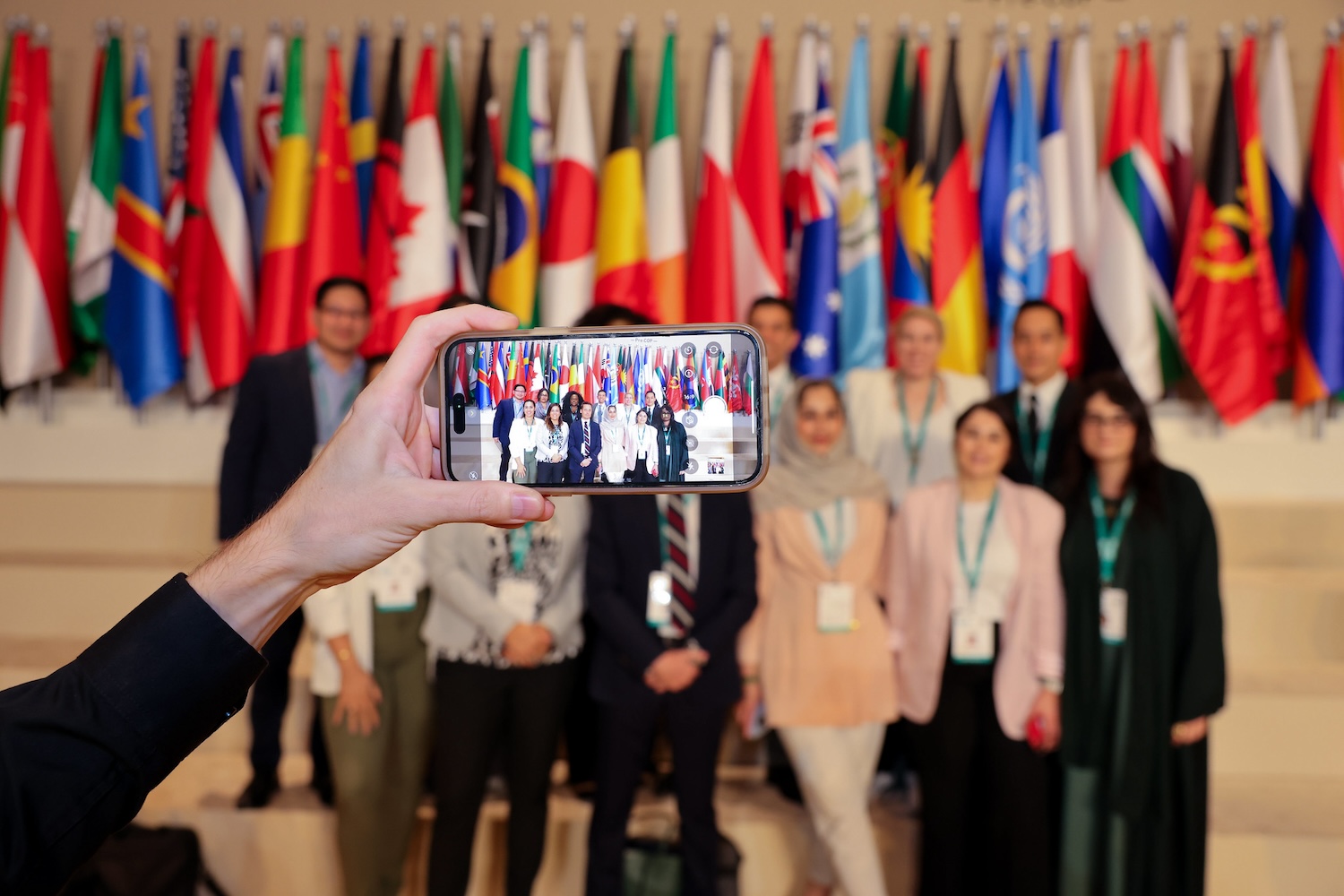
A plenary session focused on the Global Stocktake at the Pre-COP event in Abu Dhabi on Oct. 31, 2023. (Image: COP28 UAE/Flickr)
It’s that time of year again. For three decades, leaders from countries around the world have convened to discuss solutions to the climate crisis at the annual United Nations climate talks. Now, heads of state from almost every country in the world participate alongside thousands of other stakeholders including business leaders, Indigenous Peoples, activists and scientists.
The talks are recognized as the world’s only multi-country, decision-making body on climate issues. The 28th installment (COP28) begins in Dubai this week, where the stark reality of falling behind the targets set in the Paris Agreement — meant to limit the increase in global temperature to 1.5 degrees Celsius (2.7 degrees Fahrenheit) above pre-industrial levels — has ignited sentiments spanning from concern to hope, and from pragmatism to optimism.
What outcomes are anticipated from COP28? And what are the priorities for environmental groups at the summit? We spoke with teams at Oxfam, World Resources Institute, World Wildlife Fund, 350.org and Rainforest Alliance to understand the pivotal topics set to be addressed at the talks this year.
The outcome and response to the Global Stocktake is critical to pave a new way forward
COP28 is a milestone year as it will host the first Global Stocktake to evaluate the world's progress in achieving the climate goals set in the 2015 Paris Agreement, signed by 195 nations at COP21.
The Paris Agreement established the stocktake as a two-year process that occurs every five years and becomes the basis of charting a path forward. The stocktakes are meant to inform the greenhouse gas reductions each country commits to under the Paris Agreement, formally known as nationally determined contributions or NDCs, which are also updated every five years.
“We'd like to see greater ambition in our 2030 targets from countries — so really making the Global Stocktake a moment of learning and a moment of action,” said Marcene Mitchell, senior vice president at WWF.
Direction on updating Nationally Determined Contributions (NDCs) is key: “The [Global Stocktake] is a technical document that talks about economy-wide reduction of emissions,” said Ani Dasgupta, president and CEO of the World Resources Institute, in a recent press briefing. “An ideal outcome, which we don't know will happen, would be for [COP28] negotiated text to refer to the [Global Stocktake] and countries to agree that they will build their next NDC on that basis, ready for Berlin in 2025.”
The stocktake is set to be completed at COP28. But early findings indicate that current greenhouse gas reductions and commitments are not consistent with the Paris Agreement’s goal to limit global temperature rise to 1.5 degrees Celsius this century, which climate scientists deem a crucial tipping point. “For the first time, there is actual evidence of how far we are from the actions we're taking to the 1.5 degree Celsius goal that we all agreed to in Paris,” Dasgupta said. “A tougher NDC or the right NDC would be ones that takes the [Global Stocktake] into account and reflect its findings.”
In particular, sub-national governments — like cities and states — have been slow to commit to the Paris Agreement, but organizers hope this will change at COP28. “Our research shows that cities are a key vehicle to implement a climate action and raise ambition. But we see that they lack targets, especially in terms of transportation and building efficiency,” said Rogier van den Berg, global director of the WRI Ross Center for Sustainable Cities. “We expect at COP28 to see the city's voice raised with the opportunity to include more city specific targets in the revised NDCs.”
The next NDC updates are due in 2025 and must include short-term targets for reducing greenhouse gas emissions over the next 10 years. “What we need out of this COP are some strong signals about what needs to happen in those NDCs,” added David Waskow, director of international climate action at WRI’s Climate Program.

The energy transition from fossil fuels to renewables is urgent
Fossil fuels — coal, oil and gas — account for over 75 percent of global greenhouse gas (GHG) emissions and nearly 90 percent of all carbon dioxide emissions. GHG emissions trap the sun’s heat, causing global temperatures to rise.
While a commitment to phase out fossil fuels was left out of the final text at last year’s climate talks Egypt, 81 countries supported the effort. “That number has been growing, and I think there has never been that much momentum for this discussion,” said Andreas Sieber, associate director of policy and campaigns at 350.org.
To stay on track with the Paris Agreement, the global community must reduce greenhouse gas emissions by 43 percent by 2030, compared to 2019 levels, according to the latest report from the U.N. Intergovernmental Panel on Climate Change (IPCC). This reduction is crucial in order to prevent consequences of climate change, such as more frequent and severe droughts and heatwaves, scientists wrote in the report.
“We need to reduce emissions by 60 percent by 2035 … up from the 43 percent reductions that are needed by 2030,” said Waskow from WRI's Climate Program. “It's important to note that 2035 puts us well along the way to mid-century by when we need to reach net-zero globally. There has to be financial commitment to having a strong outcome next year that will underpin a country's ability to take that action in their NDCs.”
Within this conversation about a fossil fuel phase-out is a debate over whether capturing and storing carbon is a climate solution or a distraction from policies to cut down fossil fuels. It could contribute toward the goals, however not significantly, organizers said. “We know we have to reduce by about 15 gigatons of emissions. Carbon capture and storage will save us about one gigaton,” said Jennifer Layke, global director of WRI’s Energy Program.
"Phase out" or "phase down" fossil fuel production: There’s also a debate over whether to "phase out" or "phase down" fossil fuels, and this will be a focal point at the COP28 climate talks. Dasgupta from WRI says that what we should look for at COP28 is “any language that actually creates a time-bound process of reducing fossil fuel.”
Just over 150 countries committed to achieve net-zero emissions by 2050 and are discussing the transition away from fossil fuels. However, contradicting these commitments, the 2023 Production Gap Report finds that governments plan to produce around 110 percent more fossil fuels in 2030 than would be consistent with limiting temperature rise to 1.5 degrees Celsius, and 69 percent more than would be consistent with 2 degrees.
“Phasing out fossil fuels, while accelerating renewable energy, that's the very first outcome we'd like to see from COP28,” said Mitchell of the World Wildlife Fund. “We would really like to see the countries come together to talk about the eventual phase-out of fossil fuels by mid-century. And to do that, we need to accelerate renewable energy deployment. So, we would really like to see some goals around the deployment of renewable energy and the acceleration of that. It's coming, but it's not coming fast enough.”
In the run-up to COP28, the International Energy Agency identified actions that are essential to ensure the 1.5-degree goal stays within reach. This includes an orderly decline in the use of fossil fuels and tripling of renewable energy capacity by 2030. Also crucial is doubling the rate of energy efficiency progress this decade.

Climate finance for developing countries needs to scale up immediately
Twelve years ago, at COP15 in Copenhagen, wealthier nations pledged to channel US$100 billion a year to help less wealthy nations cope with climate change by 2020. This target has been repeatedly missed.
“We need to scale up that $100 billion per year finance pledged by the developed countries,” said Mitchell of WWF. “We need to align our private and public financial flows with climate objectives. We really need to start being serious about putting the funding to it.”
The Inflation Reduction Act of 2022 will bring an estimated $370 billion in climate action projects and financing into the U.S. economy and partially fund the United States’ NDC, Mitchell said. “We'd like to see that type of commitment not only on the domestic markets, but internationally between the developed world and the developing world to help them get on that path,” she said. “Without external funding, the Global South is not going to be able to meet the goals.”
Developing countries will need $200 billion to $250 billion every year by 2030 to adapt to climate change, the U.N. Framework Convention on Climate Change (UNFCCC) estimates. The Green Climate Fund, the United Nations' main fund for helping vulnerable countries cope with climate change, said earlier this year that it raised $9.3 billion — falling short of its $10 billion target after wealthy nations failed to pay in.
Meanwhile climate-related finance for the agriculture and land-use sector, particularly in low- and middle-income countries, has significantly decreased in recent years, posing a challenge to meeting the dual adaptation and mitigation goals of the Paris Agreement, said Leila Yassine, global advocacy manager for nature at the Rainforest Alliance. “We must ensure that international financial mechanisms become simpler and more accessible, allowing this finance to flow toward locally-led and nature-based solutions in the communities that need them most,” she said.
Operationalization of the Loss and Damage Fund: The Loss and Damage Fund for developing nations, established at COP27 in Sharm El Sheikh, was considered a "breakthrough agreement." However, it came without substantial pledges and no operational plan.
“We must understand that the energy crisis is unjust because those responsible for it are not suffering the consequences. The crisis is exasperating inequality between the rich and poor,” said Jacobo Ocharan, lead of the Oxfam Climate Initiative “The Loss and Damage Fund is a win, however we are extremely worried that there is no agreement on who is going to cover the fund, who will contribute and how much.”
Recently, a special U.N. committee tasked with implementing the fund met for the fifth time in Abu Dhabi, following a deadlock in Egypt last month, to finalize recommendations that will be put to governments when they meet at COP28 in Dubai. The impasse was over which entity should oversee the fund, who should pay, and which countries would be eligible to receive funding.
To get all countries on board, it was agreed the World Bank would serve as interim trustee and host of the fund for a four-year period. “If the World Bank is to host the fund, one of the criteria for them for hosting a financial intermediary fund is that three countries make a pledge to the tune of $200 million. So that's the bare minimum that one can work with,” said Preety Bhandari, senior advisor to the climate program at WRI.
The goal is to have the fund up and running by 2024.
Increased investment in renewables: Annual capital spending on clean energy in emerging and developing economies needs to expand by more than seven times, to above $1 trillion, by the end of the 2020s in order to put the world on track to reach net-zero emissions by 2050, according to the International Energy Agency.
Of the current $1.7 trillion allocated to clean energy globally, only about 15 percent is invested in the Global South outside China, Sieber from 350.org wrote in Climate Home News last month. By 2030, we will need around $1.9 trillion of yearly investment in the Global South outside China — from both public- and private-sector sources, the International Energy Agency estimates.
350.org joined more than 100 organizations in an open letter to COP28 president Sultan Al Jaber earlier this month, demanding a strong formal outcome on the energy transition. This includes the phase-out of fossil fuels, tripling of renewable energy capacity to 11,000 gigawatts by 2030, and a significant increase in concessional finance from developed countries to support a renewable, efficient, and equitable energy transition in developing countries.
The bottom line
All in all, a multitude of complex and interconnected challenges need to be addressed at COP28 for the world to get back on track. Summit President Sultan Al Jaber emphasized in his letters to parties that “it is not too late to correct course” and “we're playing catch-up to keep 1.5°C alive.” He calls for “optimism and unwavering resolve” at the talks this year, though the outcome remains to be seen.
TriplePundit will be in Dubai reporting from COP28. Sign up for our daily newsletter to follow along with our coverage.

Abha Malpani Naismith is a writer and communications professional who works towards helping businesses grow in Dubai. She is a strong believer in the triple bottom line and keen to make a difference. She is also a new mum, trying to work out a balance between thriving at work and being a mum. In her endeavor to do that, she founded the Working Mums Club, a newsletter for mums who want to build better careers and be better mums.














